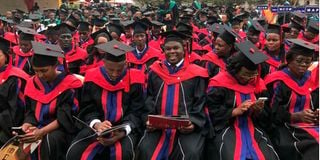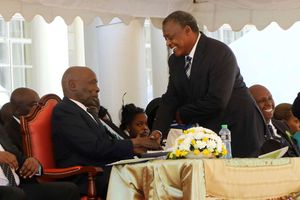Premium
What to do after missing your preferred course

Jomo Kenyatta University of Agriculture Technology graduands on June 30, 2016. To avoid pitfalls, education systems should offer students intentional post-secondary informational resources.
Acres of media space was used to discuss the poor transition from secondary school to college and university some weeks ago. Journalists laid bare the shock of more than 500,000 students who left high school in 2022 but did not seek admission to higher education institutions.
It reminded me of a young man we met in West Pokot early in the year as we engaged youth in a career readiness training. He completed high school in 2021 and scored a B+ mean grade but did not apply for college or university, resigning to his fate in the village. When asked, he said he did not know how and what to choose and that he had no money for college education.
This scenario has become common. What and how do I choose? Are there options if I miss a course?
Experience has shown that choosing courses is an overwhelming task for many a student. Experts say the task becomes overwhelming especially when students have insufficient knowledge of self and alignment to possible courses, have insufficient information and poor understanding of process, focus on grades and courses that seem glamorous, make poor choice of subjects and follow parental and peer influence or pressure.
After the self-awareness tool was administered on the young man, results showed that he was highly “conventional”. These are individuals who prefer to work in an orderly and meticulous fashion.
They stick to a certain structure in the tasks undertaken; tend to be organised and are efficient in time management. They also pay attention to small details and are inclined towards projects involving numerical aspects.
Careers that align with him could be those in computer and ICT, project management, mathematics, finance and commerce. The courses could be computer sciences, software engineering, computer technology information and informatics, programming, computer security and forensic and their related courses. In the finance and commerce cluster, he could take statistics, accounting, actuarial sciences, insurance, banking, economics or related courses.
Once the young man understood his interests, skills, abilities and talents, he was able to choose the course that spoke best to him, bearing in mind his grades, cluster points and colleges offering the programme.
He was assisted in applying for funding. The young man was surprised to know there were many courses to choose from and available to all, ranging from artisan certificate, certificate, diploma and university levels.
The science of career development shows you can never be one thing. That everyone can do several things well cannot be over-emphasised. Because of this, every student should confidently understand that there are many options available. Jackie Moraa’s self-awareness test, for instance, revealed that her main interest appeared to be in activities that involved risk-taking and influencing others. Tasks that require leading people or projects and putting ideas into action were likely to be of high importance to Moraa in finding the ideal profession.
She also had an inclination towards activities that involved communicating and working with other people. To add to that, she appeared to enjoy artistic activities that allow putting her creative flair to use. Moraa wanted to be a lawyer but the course requirements did not allow her. So, does she resign in misery? Absolutely not! There are many courses that will align 80-100 per cent with her traits. Her role is to explore the other options and see if she meets the requirements. These can be communication and related courses like public relations, journalism, advertising; business development programmes like sales, marketing, entrepreneurship, commerce; people management course like human resources, social services; design courses: graphics, interior of fashion courses and others.
The challenges students face during these transitional periods are lack of career certainty, lack of information, lack for competent career advice, poor academic preparation and transition, poor perception of higher education and lack of support.
To avoid the pitfalls, education systems should offer students intentional post-secondary informational resources, elaborate career guidance programmes for students and teachers and strategies of supporting learners improve their success. As we go through education reforms, teachers, students, parents and the government should go back to basics and review strategies that would help us achieve better transition from high school.
Margaret Waithaka is the Board chair of Career Development Association of Kenya and administrator of College of Career Guidance and Development www.ccdak.co.ke . [email protected]





